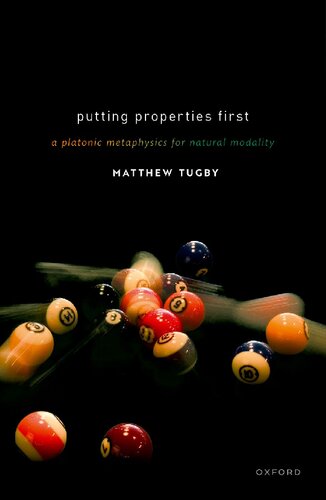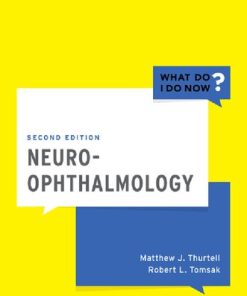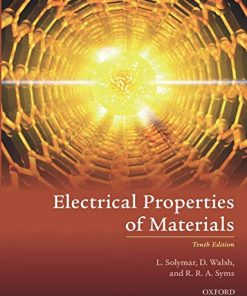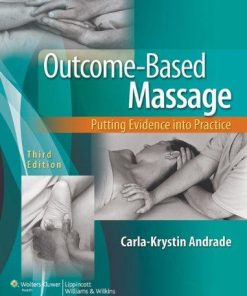Putting Properties First 1st edition by Matthew Tugby 0192597281 9780192597281
$50.00 Original price was: $50.00.$25.00Current price is: $25.00.
Putting Properties First 1st edition by Matthew Tugby – Ebook PDF Instant Download/DeliveryISBN: 0192597281, 9780192597281
Full download Putting Properties First 1st edition after payment.

Product details:
ISBN-10 : 0192597281
ISBN-13 : 9780192597281
Author : Matthew Tugby
Putting Properties First considers the metaphysics of natural science. It develops and defends a contemporary metaphysical theory of natural modality called ‘Modal Platonism’, which puts properties first in the metaphysical hierarchy. According to this theory, natural properties-such as mass and charge-are fundamental entities which ground the laws of nature and the behavioural dispositions of physical things. This theory differs from other ‘properties-first’ approaches in two main ways. First, it views properties as Platonic universals, which exist even if they are not instantiated by anything. Second, the theory rejects the popular idea that properties are identical with, or essentially dependent upon, dispositions. Instead, Modal Platonism views properties as qualities which necessarily ground dispositions and other modal phenomena. This theory solves a range of philosophical puzzles regarding dispositions and laws. Given that laws of nature are a necessary precondition for scientific enquiry, Modal Platonism promises to provide a plausible metaphysical framework for all natural science.
Putting Properties First 1st Table of contents:
1. The Scope and Aims of This Book: Properties, Laws, and Dispositions
1.1 Introduction
1.2 The Core Metaphysical Concepts of Modal Platonism
1.3 The Rival Approaches to Natural Modality
1.4 Modal Platonism in More Detail
1.5 The Big Picture
Part I: The Core TheoryModal Platonism
2. The Platonic Theory of Dispositional Directedness
2.1 Introduction
2.2 Two Metaphysical Principles about Dispositions
2.3 Properties as Tropes or Universals?
2.4 The Aristotelian versus Platonic View of Universals
2.5 Alternative Accounts of Dispositional Directedness
2.6 Conclusions
3. Against Dispositional Essentialism: A Grounding Theory of Natural Modality
3.1 Introduction
3.2 Two Kinds of Internal Relation
3.3 Against the Bradlean Conception of Dispositional Directedness
3.4 Jaag’s Formulation of the Problem Facing Dispositional Essentialism
3.5 The Leibnizian Approach: Universals as Qualities Which Ground Natural Modality
3.6 The Logical Form of Dispositional Predication
3.7 Comparison with Other Theories of Dispositions
3.8 Conclusions
4. Solving the Entailment and Governance Problems
4.1 Introduction
4.2 The Entailment Problem
4.3 What Second-Order Law Statements Do Not Entail
4.4 What Second-Order Law Statements Do Entail
4.5 Does the Reverse Entailment Hold?
4.6 The Question of Governance
4.7 Why Leibnizian Relations of Directedness Do Not Govern
5. Dissolving the Problem of Latent Dispositions
5.1 Introduction: The Problem of Latent Dispositions
5.2 Mumford’s and Bird’s Dispositionalist Accounts of Latent Dispositions
5.3 Identity Theory to the Rescue?
5.4 Psillos’s Regress Problem
5.5 Marmodoro’s Pure Powers Response
5.6 Bauer’s Pure Powers Response
5.7 Conclusions
6. Objections and Replies
6.1 Introduction
6.2 Really Realist?
6.3 Multiple Realization?
6.4 Act of Faith?
6.5 Humean?
6.6 Can Qualities Explain Dispositions?
6.7 Meta-Grounding?
6.8 Exclusion Problem?
6.9 Qualities Collapse into Powers?
6.10 Why Not Tropes?
6.11 What Is Directedness?
6.12 Not Naturalistic?
6.13 Un-Eleatic?
Part II: Putting Platonism To Work
7. Instantiation and Repeatability: A Platonic Approach
7.1 Introduction
7.2 The Explanatory Instability of Aristotelianism
7.3 The Explanatory Role of Platonic Universals: A Traditional View of Instantiation
7.4 Is There a Simpler Explanation?
7.5 Armstrong’s Aristotelian Account of Instantiation and One over Many
7.6 Conclusions
8. Probabilistic Laws
8.1 Introduction: Laws and Probabilistic Strength
8.2 Armstrong on Irreducible Probabilistic Laws
8.3 Resisting Probabilistic Causation
8.4 Armstrong’s Preferred Account
8.5 The Problem of Probabilistic Failures
8.6 The Merits of Modal Platonism
8.7 Further Considerations: Van Fraassen’s Criticisms of Armstrong’s Probabilistic Laws
8.8 Conclusions
9. Determinable Laws
9.1 Introduction: The Challenge of Accounting for Functional Laws
9.2 The Problem of Functional Laws in More Detail
9.3 Determinable Laws
9.4 The Overdetermination Problem
9.5 Solving the Overdetermination Problem
9.6 Conclusions
10. Extending Modal Platonism
10.1 Introduction: Modality in General
10.2 Non-Natural Modality
10.3 Possibility and Necessity: Platonism versus the Dominant Possible-Worlds Approach
10.4 The Richness of Modal Platonism
10.5 Platonic Modal Relations
10.6 Modal Platonism and the Argument from Unrealized Possibility
10.7 Alien Possibility and Natural Science
10.8 Further Work
10.9 Conclusions
11. Summary
Chapter 1. The Scope and Aims of This Book: Properties, Laws, and Dispositions
Part I. The Core Theory: Modal Platonism
Chapter 3. Against Dispositional Essentialism_ A Grounding Theory of Natural Modality
Chapter 4. Solving the Entailment and Governance Problems
Chapter 5. Dissolving the Problem of Latent Dispositions
Chapter 6. Objections and Replies
Part II. Putting Platonism to Work
Chapter 8. Probabilistic Laws
Chapter 9. Determinable Laws
Chapter 10. Extending Modal Platonism
People also search for Putting Properties First 1st:
what property should franklin buy first
first property benefits
first steps to adding onto a house
first thing to do before buying a house
putting first
Tags: Putting Properties, Matthew Tugby, metaphysics, Modal Platonism
You may also like…
Fiction - Westerns
Comics & Graphic Novels - Comics & Graphic Novels - General & Miscellaneous
Through Their Eyes: A Graphic History of Hill 70 and the First World War
Medicine - Clinical Medicine
Uncategorized
Engineering
Fiction - Westerns
Stranded 1st edition by Matthew Mayo 1432834045 978-1432834043












